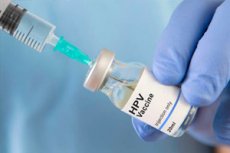New study shows continued high effectiveness of HPV vaccination
Sist anmeldt: 14.06.2024

Alt iLive-innhold blir gjennomgått med medisin eller faktisk kontrollert for å sikre så mye faktuell nøyaktighet som mulig.
Vi har strenge retningslinjer for innkjøp og kun kobling til anerkjente medieområder, akademiske forskningsinstitusjoner og, når det er mulig, medisinsk peer-evaluerte studier. Merk at tallene i parenteser ([1], [2], etc.) er klikkbare koblinger til disse studiene.
Hvis du føler at noe av innholdet vårt er unøyaktig, utdatert eller ellers tvilsomt, velg det og trykk Ctrl + Enter.

England's human papillomavirus (HPV) vaccination program not only led to a significant reduction in cervical morbidity, but achieved this across all socioeconomic groups, says a study published in The BMJ.
Although women living in the most deprived areas remain at increased risk of cervical disease compared with women in less deprived areas, the results show that well-planned and implemented public health interventions can both improve health and reduce inequality in health care.
About HPV and the vaccination program
HPV is one of the most common sexually transmitted infections. Many countries, including the UK, now offer routine vaccination to girls and boys aged 12–13 years to protect against strains that can cause cancer later in life.
In England, the HPV vaccination program began in 2008, with additional vaccination for 14–18 year olds from 2008 to 2010. However, because cervical cancer rates have always been higher in the most disadvantaged groups, there is concern that HPV vaccination may be least effective at protecting those most at risk.
Purpose of the study
To explore this question, the researchers analyzed NHS England data on vaccinated and unvaccinated women aged 20–64 years living in England from January 2006 to June 2020 to assess whether the high effectiveness of HPV vaccination continued with an additional year of follow-up, from July 2019 to June 2020.
Research methodology
The team used the Index of Multiple Deprivation, which divides local areas into five equal groups - from most to least deprived - to assess the impact of the vaccination program based on socio-economic deprivation.
Between January 1, 2006, and June 30, 2020, there were 29,968 cases of cervical cancer and 335,228 cases of stage three precancerous cervical lesions (CIN3) in women aged 20–64 years.
Research results
In the group of women who were offered vaccination at age 12–13 years, rates of cervical cancer and CIN3 in the additional year of follow-up were 84% and 94% lower, respectively, than in the older unvaccinated group. Overall, the researchers estimated that by mid-2020, HPV vaccination had prevented 687 cases of cancer and 23,192 cases of CIN3. Rates remained highest among women living in the most deprived areas, but the HPV vaccination program had a significant impact across all five deprivation levels.
For example, the most cases of cervical cancer were prevented in women from the most deprived areas (192 and 199 cases in the top and bottom fifths, respectively) and the fewest cases in women from the least deprived fifth (61 cases averted)..
The number of CIN3 cases averted was also high across all deprivation groups, but highest among women living in more deprived areas: 5121 and 5773 for the first and second fifths respectively, compared with 4173 and 3309 for the fourth and fifth fifths, respectively.
For women who were offered additional vaccinations aged 14–18 years, CIN3 rates fell more for those from the least deprived areas than those from the most deprived areas. However, for cervical cancer, the strong downward gradient from high to low deprivation observed in the older unvaccinated cohort was no longer present among those offered vaccination.
Conclusion
This is an observational study, so no firm conclusions about causation can be made, and individual-level data on vaccination status were not available. However, randomized controlled trials have shown conclusively that the vaccine works in preventing HPV infection and in preventing CIN3 in women free of HPV at the time of vaccination.
More importantly, the authors say this was a well-designed study based on high-quality data from a national cancer registry, making it "powerful and less prone to confounding bias than analyzes based on individual data on vaccine status." HPV."
They therefore conclude: “The HPV vaccination program in England is not only associated with a significant reduction in the incidence of cervical neoplasia in the target cohorts, but also across all socioeconomic groups.”
They add: “Cervical screening strategies for women who have been offered vaccination should carefully consider the differential effect on both incidence rates and inequalities that are evident among women who have been offered additional vaccination.”
US researchers in a linked editorial emphasize the importance of achieving the 90% vaccination coverage goal recommended by the World Health Organization, but acknowledge several challenges such as vaccine reluctance, financial issues, health system capacity, supplies and differences in how medically employees recommend vaccination.
To overcome the challenges of achieving target coverage and maximizing herd immunity, “a collaborative effort between government, public stakeholders and medical professionals in these countries is needed,” they conclude.
